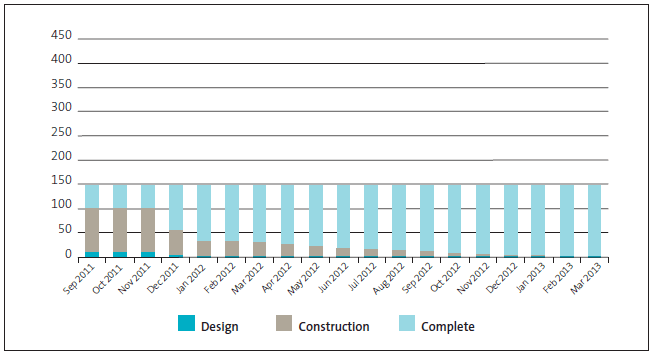Appendix 1: Circumstances leading to the formation of the Stronger Christchurch Infrastructure Rebuild Team
In response to the earthquake in Canterbury on 4 September 2010, Christchurch City Council (CCC) set up an Infrastructure Rebuild Management Office (IRMO) with a team of 20-30 staff to manage the reinstatement of infrastructure and oversee repairs. IRMO was responsible for design, construction management, finance, communication, programming, procurement, and project administration.
CCC discovered that the most damaged infrastructure was concentrated in four areas of Christchurch, so it entered into four design-build contract arrangements with four construction companies to rebuild one area each. The aim was to repair the worst affected areas as quickly as possible. McConnell Dowell Constructors Limited and Fletcher Construction Company Limited (working together in a joint venture), Fulton Hogan Limited, Downer New Zealand Limited, and City Care Limited were selected through a competitive tender process. (Appendix 2 contains further information on these companies.)
The situation changed on 22 February 2011, when another earthquake struck Christchurch just 10km from the central city. The second earthquake caused much more widespread damage than the first, and CCC soon recognised that the arrangement it had was no longer suitable for the larger size and scale of the task.
The Government also recognised the need for a different approach. It set up the Canterbury Earthquake Recovery Authority (CERA) through the Canterbury Earthquake Recovery Act 2011 to ensure the effective, timely, and co-ordinated rebuild and recovery of Canterbury. The Government sought guidance from the New Zealand Transport Agency (NZTA) on an appropriate response to deliver the horizontal infrastructure rebuild. NZTA is experienced in alliancing-style contracts.
NZTA supported the alliance approach, believing that it would be the fastest way to meet the needs of the people of Christchurch. As the foremost authority on alliancing-style contracts in New Zealand, NZTA offered to work alongside CERA, acting on its behalf until the central government agency was fully established.
CCC and NZTA worked together to review various options. Based on their analysis, they concluded that an alliance delivery model would deliver the best outcome. It was thought that other possible models, such as "Design and Construct" or "Managed Contractor Model", would not deliver with the speed required, would be complex in administrative layers, and would not effectively bring together organisations with differing objectives.
By 22 February 2011, the four contractors working under the IRMO arrangement were either starting physical works or planning to start physical works in their areas later that month. It was therefore proposed that the existing head contractors would be engaged to work as part of SCIRT.20
The contractors were asked to produce a co-ordinated response to a request for proposal. They formed an unincorporated joint venture, known as the Stronger Christchurch Infrastructure Rebuild Team Joint Venture, so that they could participate in a collaborative alliance with the owner participants. The Alliance Agreement sets out the roles and obligations of the owner and non-owner participants in the Alliance.
It was acknowledged at the time that decisions made for the wider Canterbury recovery would affect the scope and scale of the horizontal infrastructure required. Reinstatement planning would have to be done with the future needs of Christchurch in mind. It would also need to be integrated with the proposed recovery plans to be prepared by CERA.
The programme is planned to be completed by December 2016, although this could be subject to further review.
Transition from IRMO to SCIRT
We note that, although SCIRT has been in existence since September 2011, for much of its life SCIRT has been working on projects started under IRMO. For example, more than half of the projects in construction during March 2013 were likely to have originated under IRMO. These projects are generally much smaller than SCIRT-defined projects and are lacking some of the features produced for SCIRT projects, such as a target cost.
Once SCIRT had been established, a transition plan governed the transition of existing projects from the IRMO mode of operation to the SCIRT mode of operation. SCIRT took over 148 projects from IRMO that were advanced enough to be defined as IRMO projects, and another 125 projects that were redefined as standard SCIRT projects. By April 2013, construction of all pure IRMO projects had been completed (see Figure 13).
Figure 13
Number of IRMO projects in various stages of construction

Source: SCIRT.
Most of the projects redefined as SCIRT projects had been carried over from IRMO in the design phase. By April 2013, a small number of these had completed construction. New projects since September 2011 are following the SCIRT delivery model from conception to completion. By April 2013, a small number of these were reaching completion and were being handed over.
As time passes, the number of IRMO residual projects will decrease to nothing, and the proportion of work carried out on pure SCIRT projects will increase.
20 The McConnell Dowell and Fletcher joint venture separated for the purposes of the Alliance.
page top
